Forest & Shade Tree – Insect & Disease Conditions for Maine
May 31, 2022
Hello from your Forest Health and Monitoring team. We hope you've enjoyed a good spring! And we want to let you know that each month the Maine Forest Service will host a webinar on a forestry topic. Unless otherwise advertised, they will be live on the third Friday of each month at 9 am and will be recorded and posted online for future viewing. Information is posted on the Maine Forest Service Calendar. In June, our division will host Cameron McIntire, Plant Pathologist with the USDA Forest Service in Durham, NH, for a discussion of beech leaf disease. May’s program, The Problem of Invasive Mycorrhizal Fungi, featured an excellent presentation by Anne Pringle, Ph.D., Professor of Botany, University of Wisconsin. In April, Maine Forest Service’ own Kent Nelson provided information on ways to reduce the likelihood of wildfires occurring on your woodlot and near your homes. We will be announcing future topics soon; stay tuned and tune in!
In This Report:
Please join us in welcoming our 2022 summer interns, Josie Miller and Kelby Leary. Josie returns to us after one prior season under her belt in 2020, and Kelby has hit the ground running. So far, they have helped collect samples for our various exotic insect surveys, learned to identify beech leaf disease, and are now running around hanging purple prism traps for our statewide emerald ash borer detection survey. Both have (wisely) expressed interest in pursuing a career in forest health, and we hope this experience will help them on their way.
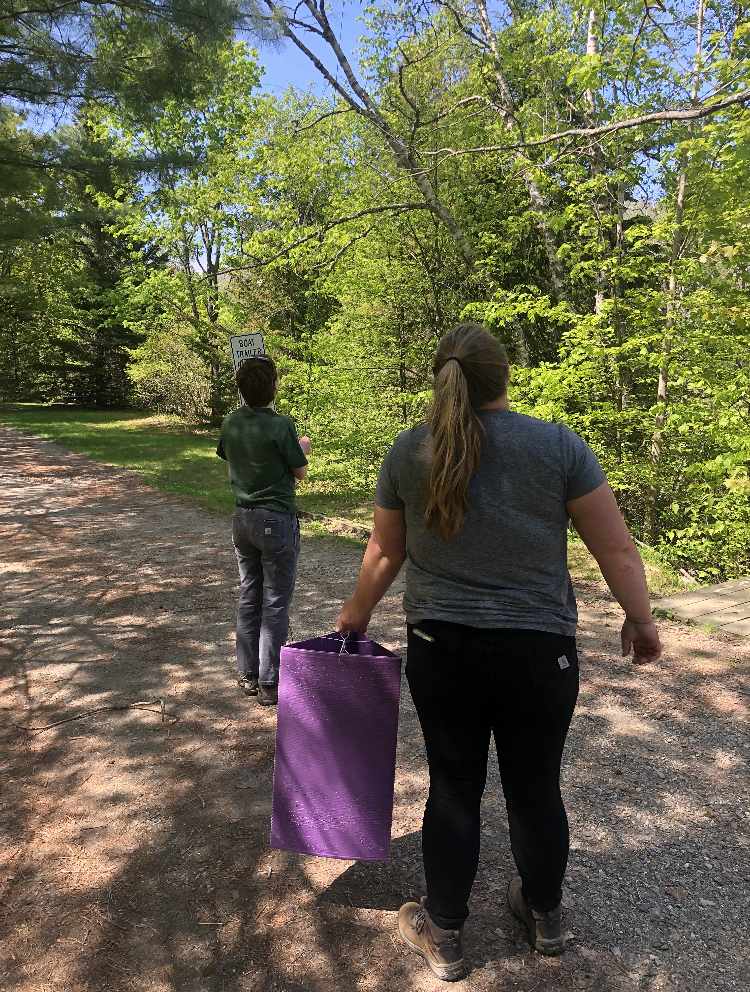 Image: 2022 summer interns Josie Miller and Kelby Leary carefully size up their next target, an ash tree branch, as a suitable site to hang a purple prism trap.
Browntail Moth (Euproctis chrysorrhoea)
Since our last conditions report, browntail moth caterpillars across the state appear to be feeding and growing at an average pace. We’ve been seeing fourth instar (life stage) caterpillars for about a week and a half now at all of our developmental monitoring sites. Fourth instar and older caterpillars have white markings on the sides of each body segment and have more of the irritating hairs that affect humans. At this stage of caterpillar development, their activity and appetites increase rapidly, increasing the number of irritating hairs and diminishing leaf area. We expect a sharp rise in call volume in the coming weeks coinciding with more defoliation and larger browntail moth caterpillars, as there is already a report of damage from as far north as Bangor. As of last week, we’ve observed a high rate of variability in caterpillar development within sites. For example, at one of our monitoring sites, there are caterpillars that are 23 mm long alongside 9 mm caterpillars (indicating little development since emergence).
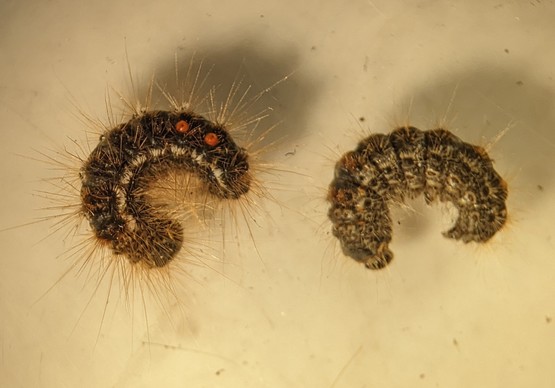 Image: Comparison of 3rd (Right) and 4th (Left) instar caterpillars, note the white tufts on each side of the body segments and the more abundant hairs.
The windy weather last week seems to have hastened the process of the caterpillars leaving their host trees, as many were blown to the ground. This means that there may be an increased chance of folks coming into contact with the caterpillars, so caution should be exercised as always in high-infestation areas.
If you wish to remove caterpillars from decks, buildings, driveways and other surfaces, we recommend doing it in a way that will not increase your risk of exposure to their hairs (No leaf blowers allowed! We’ve seen the trouble this can cause as it stirs up and distributes even more caterpillar hairs). You can dislodge them from out-of-reach areas with a strong jet of water from a hose. To remove them more permanently, try adding a couple of inches of soapy water to the canister of a wet/dry vacuum, vacuum them up, and allow them to sit until the caterpillars have drowned. Then safely dispose of the contents, bearing in mind the toxin in the hairs is still viable.
Most insecticide treatments should be completed by now. In most years, treatments should be completed before the end of May to limit buildup of toxic caterpillar hairs and foliage loss. We recommend working with a reputable and experienced licensed pesticide applicator for insecticide treatments. If you had a population of browntail moth that you wish you had managed this spring, it is not too early to start researching a solution for next year.
In some locations, we have noticed caterpillars that have been killed by a fungal pathogen. In the right situation, this can lead to a significant population reduction. We inoculated three sites late last week (Deer Isle, Cumberland, and Chelsea) with fungus-killed caterpillars to test if this is a viable method for assisted disease dispersal. The cloudy and rainy days last week that are beneficial to tree health may also aid in the natural spread of the fungus and a virus that attack BTM. We are eagerly keeping an eye out for these disease-causing agents at our developmental monitoring sites and elsewhere.
Carrion Beetle (Nicrophorus pustulatus)
One of the interesting parts of the insect surveys conducted by the Maine Forest Service Insect & Disease lab is the bycatch, or those insects unintentionally collected in our traps while we attempt to capture others. Given the incredible diversity of the insect world, it’s safe to say you never know what you’re going to get.
Insects have figured out ways to exploit every niche imaginable and play an important role in decomposition and disposal of dead organic matter. True to name, carrion beetles make their living by feeding and breeding on dead organisms and are no strangers in our insect traps. The most common species feature distinct orange markings and are easily identified, but a less familiar carrion beetle lacking these typical markings appeared in one of our traps this week.
The beetle was identified as Nicrophorus pustulatus easily enough. However, the identification process revealed some interesting life history information. Unlike some other carrion beetles that use small mammal carcasses, this species is believed to rely on snake eggs for reproduction, a relationship accidentally discovered by snake researchers in Ontario and later documented again in Illinois (specifically the Eastern rat snake, Antherophis alleghaniensis, that share large communal nests). Perhaps it’s no coincidence that this particular trap site is full of abandoned stone walls that should provide excellent habitat for snake dens. This relationship has also been documented with Northern ringneck snakes and could likely extend to other snake species. Additionally, lab experiments have shown that N. pustulatus can also use turtle eggs to some degree. This is an unusual relationship even in the insect world and highlights just how much remains to be learned about the incredible insects living right here in Maine
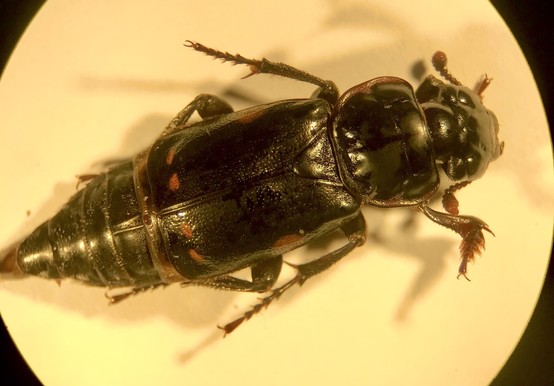 Image: Adult Nicrophorus pustulatus beetle recovered in a funnel trap.
Caterpillar Comparison (Various species)
Browntail moth caterpillars are not the only fuzzy caterpillars observed recently. We have also received images and made observations of forest tent (Malacosoma disstria), eastern tent (Malacosoma americanum), and spongy moth (Lymantria dispar) caterpillars. Below we share some of those observations from the Bangor area. Learn more information in this video distinguishing between some of Maine’s hairy caterpillars.
Maturing forest tent caterpillars are also starting to show their characteristic central white spots and blue coloration. The spots are variously described as footprint, keyhole, or penguin shaped and are sometimes off-white. This is also a native species that does little damage to trees in small populations. They are an occasional outbreak species, and recently contributed to a small pocket of oak mortality in Blue Hill.
Eastern tent caterpillars can be found in both wild and cultivated fruit trees. More mature caterpillars have a central white stripe down their backs. These native caterpillars can be considered beneficial because they provide important food for predators and parasitoids that also attack browntail moth. However, if they are in a prized fruit or ornamental tree, you may still want to remove them. To remove them, you can twist a forked stick in the web (think cotton candy) and then move it to a wild cherry or serviceberry tree or dispose of it in a manner similar to browntail moth. It is important to do this in the evenings when the caterpillars have come home to “roost” together in the nests for the night.
 Image: (left) Forest tent caterpillars feeding on foliage in Orono; (right) Eastern tent caterpillars basking in the sun in Orono. May 19, 2022. Courtesy of Megan Schneider
In the Bangor region, spongy moth caterpillars have recently hatched. During this stage, they will “balloon” or travel on the wind using a strand of extruded silk. Like browntail moth, this species is introduced. Similar to its close relative, browntail moth, it is currently in outbreak-level populations in parts of Maine. The characteristic knobs on the side of the head capsule are the easiest identification clue for spongy moth caterpillars at this early stage of their development. There is more on this species later in this bulletin.
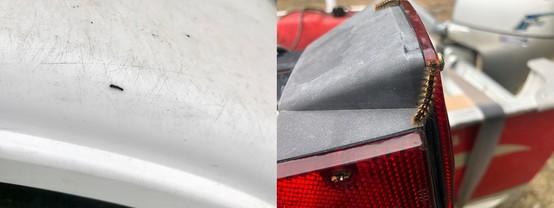 Images: (left) Spongy moths like this early instar caterpillar spread easily to new areas via human transport; (right) Don't bring browntail moth home with you- check trailers and vehicles for any caterpillars hitching a ride.
Browntail moth caterpillars are in varying stages of development, as are all the species covered here. Look for the characteristic glandular orange dots and the white tufts of hair. A note on the orange dots, spongy moth and browntail moth are both in the Lymantriinae subfamily (former Lymantriidae family). Caterpillars in this subfamily generally have two glands on the top of their body towards the tail end (dorsal side, segment A6 and A7). The orange dots are a good identification clue for browntail moth, and a good ‘don’t touch’ reminder, but not all caterpillars with these dots are browntail moth.
 Image: Spongy moth caterpillar showing glands (horizontal arrow) and knobs beside head (vertical arrow).
These caterpillars are quite capable hitchhikers; you can read more in our recent bulletin.
Emerald Ash Borer (Agrilus planipennis)
In 2019 and 2020, three species of parasitoids were released in northern Aroostook County to manage emerald ash borer (EAB). We felled several trees this spring to look for parasitoid larvae, but no signs of parasitoid activity were found. We will monitor for adults in mid-late summer. In northern Maine, EAB typically takes two years to complete its life cycle, and early in the infestation, the cohorts of EAB seemed to be largely synchronized. This may mean that in some years there were plenty of EAB life stages available to be parasitized, but in alternate years there may have been very few, making it harder for the parasitoids to establish. In the four years since we first discovered EAB in northern Maine, that synchrony appears to be breaking down, and all life stages appear to be present every year. We will be releasing more parasitoids at a new site in northern Maine this summer and will hope for a better establishment. We do not expect to see this delay in establishment in southern Maine, where the EAB life cycle typically takes only one year. Our neighbors in New Hampshire have recovered parasitoids from most of their release sites, so we are hopeful we will also recover them when we start looking in 2023.
Hemlock Borer (Phaenops fulvoguttata)
Hemlock borer is a native insect in the Buprestid (flatheaded borer) family that feeds on weakened or dying hemlock trees. It is generally considered a secondary pest and may attack trees weakened by prolonged drought or infestations of other insects such as hemlock woolly adelgid and elongate hemlock scale. Like other flatheaded borers, larvae feed under the bark and leave distinctive tracks or galleries. Usually, the first recognized sign of an infestation is woodpecker feeding as woodpeckers remove the dark outer bark and expose the reddish inner bark (similar to how woodpecker feeding can reveal ash trees infested with emerald ash borer).
In the past, widespread outbreaks have rarely been seen. However, hemlocks in southern Maine have already been predisposed to hemlock borer attack by various stressors, including forest pests, drought, and root disturbance. For readers living in or visiting the area, examples of more severe hemlock borer activity can be seen in places such as the Mt Agamenticus Conservation Region and along trails within the York Water District around Chases Pond. In some areas, previous forest management may have damaged the roots of hemlock trees and canopy removal has resulted in the warming of the soils. Other easily viewed examples of hemlock borer damage can be seen right along I-95 and I-295 in southern Maine. Harvesting activities to move the tree line further back from the road have resulted in damage to the root systems of these hemlocks, especially those growing on ledges with shallow soils.
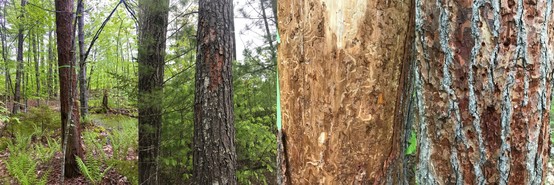 Images: (left to right), light woodpecker feeding on hemlock borer; heavy woodpecker feeding on hemlock borer; hemlock borer larval galleries; closeup of woodpecker feeding exposing red inner bark.
Hemlock Woolly Adelgid (Adelges tsugae)
Three species of predators for hemlock woolly adelgid (HWA) have been released in Maine over the past couple of decades. Sasajiscymnus tsugae feeds primarily during the spring and summer, while Laricobius nigrinus and Laricobius osakensis feed on the overwintering generation of HWA. Relatively few Laricobius have been released, and we have often not had much success in finding them in subsequent years. However, last year a researcher monitoring for larvae in the spring, rather than monitoring for adults in autumn, recovered a high number of Laricobius species.
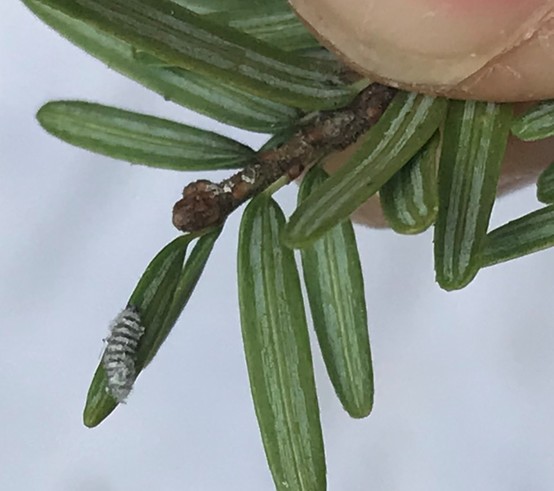 Image: Laricobius sp. larva on a hemlock needle.
Spongy Moth (Lymantria dispar)
While we can’t say we’re thrilled about the number of spongy moth calls we’ve received already this season, we can celebrate the number of accurate identifications we’ve seen of these tiny early instar caterpillars –keep up the good work, callers!
As expected, many of the reports we’ve received to date have come from the core outbreak areas of southern Oxford County, where we expect another damaging season of defoliation. Our April optimism for favorable spring weather conditions for disease spread among caterpillar communities has now faded somewhat, as during May we have already been experiencing abnormally dry and moderate drought conditions in parts of Maine. We expect the calls reporting true defoliation damage to begin in the upcoming weeks and expect to document a great deal of defoliation damage during our upcoming aerial surveys in June and July.
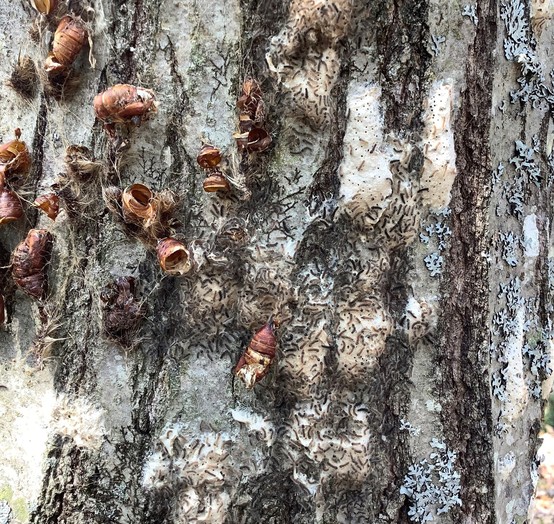 Image: Spongy moth egg hatch and early instar caterpillars in the Jay/Canton area on May 12, 2022.
There is a limited amount of time to exert some targeted management, and we recommend consulting our list of licensed pesticide applicators to see what options may be available to you if considering insecticide treatments. It is important to remember that this current spongy moth outbreak is part of a typical outbreak cycle occurring over a huge region, in this case spanning the US-Canada border Maine to Michigan and other locations in northeastern North America as well. If we experience a large increase in populations in 2022 as anticipated, we will retain some optimism in the fact that “the bigger they are, the harder they fall.” While the damage can be severe over the course of a few years, population crashing disease outbreaks with the caterpillar population will help reduce the number of years the impact of the current outbreak is felt.
We would appreciate your reports of damage by this insect, especially outside of the southern Oxford County and Jay/Canton area.
Winter Moth (Operophtera brumata)
The annual release of Cyzenis albicans flies, the biocontrol agent for winter moth, occurred on May 5, in South Bristol. Although we only had 329 flies to release this year, it was still more than the previous two years of releases. We had excellent emergence this year with mating observed as well. Now in late May, we are gearing up to collect caterpillars from our previous release sites. Flies reared from any parasitized caterpillars collected will serve as the source for next year’s release. In addition, these collections will show where the parasitoid has established successfully and what proportion of the winter moth population it is being parasitized.
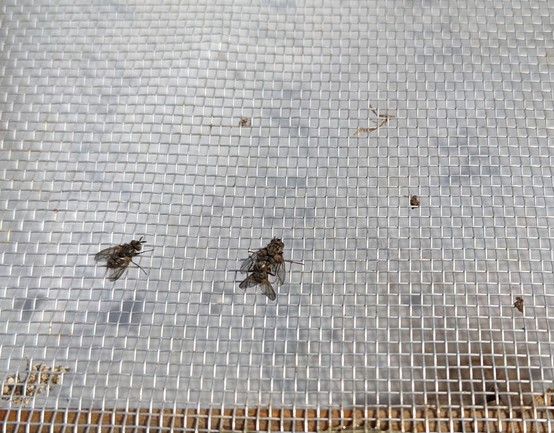 Image: Newly emerged Cyzenis albicans mating.
Beech Leaf Disease (Litylenchus crenatae mccannii)
Beech leaf disease (BLD) was found for the first time in Maine in late May 2021. Peak symptomology is most easily seen in summer after full leaf expansion; however, now is not too early to scout your land for this new and somewhat mysterious disease of beech trees (it is still not clear how the disease spreads). Dark banding between leaf veins is a reliable symptom of BLD and is thought to be the result of overwinter feeding activity by a foliar nematode (the causal agent of BLD). This banding symptoms is most easily observed by looking up into the beech canopy or holding beech leaves up to the light. Maine’s current infestation centers around the Midcoast Maine counties of Waldo and Knox, although the disease has been confirmed in two locations in Penobscot County and several locations along Augusta Road in Lincoln County. On the most recent visit to Lincolnville and Hope (Waldo and Knox counties, respectively), severe leaf symptoms and a high degree of aborted buds were seen. Leafless trees were commonly seen in the understory and even some mature trees that had a full complement of leaves last year were almost entirely leafless. This rapid decline may lead to mortality in the short term compared to the longer-term decline seen in states further west where BLD was first described. In addition to interveinal leaf banding, leathery leaves, strappy leaves, curled leaves and undersized leaves are other symptoms one may find on beech trees. For more pictures of BLD symptoms and other current BLD information in Maine, visit our BLD webpage. If you see symptoms of BLD, please take some pictures and contact the MFS Insect and Disease Lab to report the observation.
 Images: (left) A map of the current distribution of BLD in Maine; (collage, top left) An understory beech tree with sparse, symptomatic foliage and many aborted buds, Karen Coluzzi, Maine Dept. of Ag; (top right) Clear banding of newly emerged beech foliage; (bottom left) Roadside mature beech trees with very sparse foliage; (bottom right) A codominant beech tree showing severe BLD symptoms of aborted buds and sparse, deformed foliage.
European Larch Canker (Lachnellula willkommii)
European larch canker (ELC) is caused by a non-native fungal pathogen. It is federally regulated due to its destructive nature, causing lower branch dieback and deforming cankers on the main stem of younger trees and occasionally older trees. The disease was first reported in Washington County, Maine in 1981. Surveys in the following years led to further discoveries of the pathogen in larch growing in several townships in Downeast and Midcoast Maine. Survey for ELC has been traditionally been done in late summer, with crews looking for early senescing foliage on branches – a potential sign of ELC cankers actively killing the cambium and girdling branches. This winter MFS intensified winter survey for this disease. Eastern larch is often found growing in wet areas, especially in bogs. While these areas are not accessible during the growing season, in late winter they are frozen and are able to be accessed on foot or snowshoes for closer examination of trees. In February and March of this year MFS staff conducted ground surveys in several larch-rich areas outside of the current ELC quarantine area.
ELC was found in three new townships: Aurora, T28 MD, T30 MD. Additionally, other native Lachnellula spp. were found growing on larch, enhancing our understanding of these Lachnellula species in Maine that, unlike their non-native relative ELC, are known to be saprophytic or mildly pathogenic in rare circumstances. Samples were collected during the survey and submitted on our behalf by APHIS in Hermon, ME. Fungal identifications were verified by a U.S. Department of Agriculture national fungal identifier located in Beltsville, MD. The new ELC finds are depicted in the map below. The current quarantine boundaries will not change in the short term, however, the boundaries will be reviewed and updated following more extensive late winter survey in 2023.
 Images: (left) ELC impacting the main stem of a larch tree and the same tree with the bark removed to show the necrotic (dead) area killed by the fungus; (middle) a fine twig with a small swelling due to ELC infection, orange arrows point to the spore-producing structures (apothecia) on the canker margins; (right) The white-haired apothecia of ELC with a close-up picture inset (Megan Romberg, USDA APHIS PPQ NIS); (below) The ELC quarantine map as of April 28, 2022, with new towns circled in red.
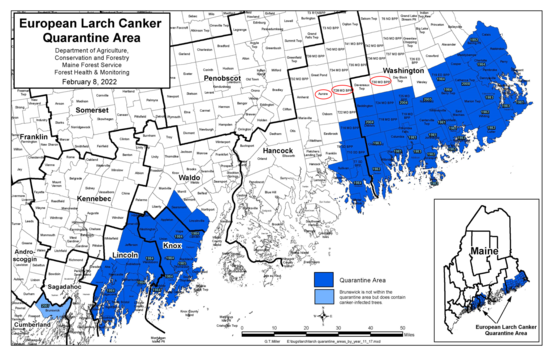 Lichens on trees, Algae on trees
Already this year the Insect and Disease Lab has received reports of tree disorders that have turned out not to be disorders at all: lichen and algal growth. Trees are hosts to a wide variety of organisms such as the typical birds, mammals, insects and harmless fungi. Lichens are one such organism growing on the surface of trees that sometimes go unnoticed. However, lichen growth is sometimes noticed and misidentified as a threat to tree health due to the growth habit and coloration of certain lichen species. The growth of foliose (leaf-like) lichens can resemble branch swellings or insect nests, especially if the growth occurs higher up in a tree where closer observation is not possible. The growth of crustose (crust-like) lichens is tight to the bark, without loose edges, and can be mistaken by some for molds or fungal growth. The growth of fruticose (upright, hair-like, cup-like, etc.) lichens can resemble mushrooms or unusual growths. Lichens are also sometimes reported due to their alarming red, orange, black, or yellow coloration. They can colonize all aboveground parts of tree and are often reported on bark, twigs, and especially dead branches in the lower crown. Some callers have insisted that lichens have killed the branches, but this is not the case. Lichens only use tree surfaces to grow upon and do not derive any nutrients from the tree or harm it in other ways. In fact, seeing lichens on your trees can be considered a good sign, as lichens are sensitive to pollution and do not thrive in areas with poor air quality.
Similarly, the so-called ‘red bark phenomenon’ has been increasingly reported in recent years and is thought to be caused by a red filamentous alga in the genus Trentopohlia. Although the exact identification of this tree-inhabiting alga is not fully clear, the growth is superficial, and no break of the cambium occurs that would indicate parasitism/pathogenicity. It appears the ‘red bark phenomenon’ is nothing to worry about.
So, when given the chance, take a closer look at these interesting and complex organisms and enjoy their abundance and diversity as parts of a healthy forest environment.
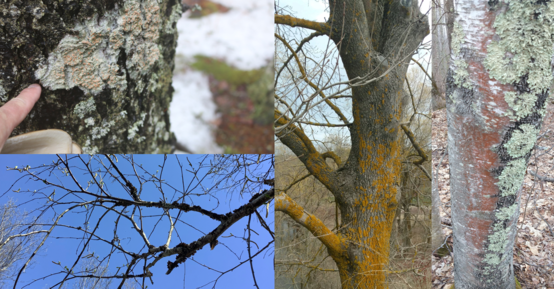 Images: (top left) A crustose lichen on a poplar tree; (bottom left) Foliose lichen growth on birch branches that resemble galls in certain lighting; (middle) Orange lichen growing on the main stem of a tree; (right) Red filamentous algae, almost resembling spray paint on the main stem of a birch tree next to abundant lichen growth.
Preparing for Oak Wilt: Do NOT to prune oaks in May through September
Oak wilt (Bretziella fagacearum) is not currently found in Maine, and our hope is to keep it that way. Oak wilt is a destructive wilt fungus, with some similarities to Dutch elm disease, that is capable of killing all oak species native to Maine. Further, if oak wilt arrives in Maine, it will be difficult and costly to manage. Thus, it is good to get into the habit of best cultural practices that help prevent the spread of oak wilt, primarily not pruning oaks from May to September. If one must prune during this time, or if an oak is injured somehow, a wound sealer should be applied. Tree wound sealing products available at a nursery or a ‘big box’ store are among appropriate choices – even latex paint can be used. However, things like tars, creosote or other toxic substances are not suitable and can do more harm than good. Wound sealing is crucial to preventing sap-feeding beetles (Nitidulidae) from visiting the wound and infecting the wounded tree. Sap-feeding beetles are the primary vectors of the oak wilt fungus and do what their name implies – feed on sap. While they are attracted to wounds, they are also lured to the spore-producing structure of the oak wilt fungus, which emits a fruity smell that the beetles find irresistible. After visiting a spore-producing structure and not finding the sap they were hoping for, spore-covered beetles naturally seek wounds on other trees, and if they visit a wounded oak, that tree becomes infected. After infection, an oak tree rapidly develops symptoms and may die in as little as a month.
Symptoms of oak wilt can be variable, ranging from wilted/discolored leaves to wilted branches and whole-tree symptoms. However, one symptom is highly typical of trees infected by the oak wilt fungus: oak trees dropping their leaves during summer. If you witness this symptom, please contact the MFS Insect and Disease Lab at (207) 287-2431. For more information about oak wilt, visit www.maine.gov/forestpests#OWD, or contact Aaron Bergdahl, Forest Pathologist: (207) 287-3008.
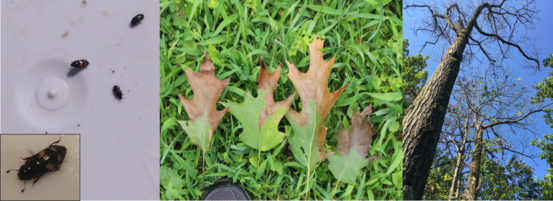 Images: (left) Nitidulid beetles on the lid of a maple sap bucket (inset) a close-up of a beetle – note the colorful markings and clubbed antennae; (middle) A range of leaf symptoms among leaves prematurely dropped by an oak tree in summer after being infected with the oak wilt fungus; (right) Dead and dying oak trees in a park in Pennsylvania.
From the May 18, 2000 Condition Report:
“Pine Shoot Beetle (Tomicus piniperda)- NEW STATE RECORD from Roger Cyr of the USDA/APHIS in Bangor: On May 10, an employee collected one beetle in a Lindgren funnel trap located in a red and Austrian pine plantation. This site is near a Maine Forest Service fire station on Route 16 on the northeastern corner of Adamstown Township. The site is in northern Oxford County about 11 miles east of the Maine-New Hampshire border and about 15 miles south of the Maine-Quebec border.”
June 17, Overview of Beech Leaf Disease - Forestry Friday Webinar, 9:00am, Virtual. Get an update on the current situation of Beech Leaf Disease in Maine from Cameron McIntire, Plant Pathologist with the USDA Forest Service in Durham, NH. Register here by this link to send an email to foresthealth@maine.gov.
Conditions Report No. 2, 2022
On-line
Department of Agriculture Conservation & Forestry, Maine Forest Service – Forest Health and Monitoring
Contributors: Aaron Bergdahl, Amy Emery, Mike Parisio, Colleen Teerling, and Thomas Schmeelk
Unless otherwise noted, images by Maine Forest Service, Forest Health and Monitoring, DACF

|